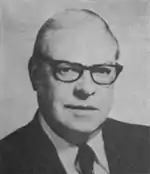John G. Fary
John G. Fary (April 11, 1911 – June 7, 1984) was a U.S. Representative from Illinois. He represented the Illinois's 5th congressional district
John G. Fary | |
|---|---|
 | |
| Member of the U.S. House of Representatives from Illinois's 5th district | |
| In office July 8, 1975 – January 3, 1983 | |
| Preceded by | John C. Kluczynski |
| Succeeded by | Bill Lipinski |
| Personal details | |
| Born | April 11, 1911 Chicago, Illinois |
| Died | June 7, 1984 (aged 73) Chicago, Illinois |
| Political party | Democratic |
Born in Chicago, Illinois, Fary attended Saint Peter and Paul grammar school and graduated from Holy Trinity High School. His father was a tavern owner. He grew up in the "Back of the Yards"/McKinley Park neighborhood of Chicago's Southside. He attended Loyola University Chicago, Real Estate School of Illinois and Mid-West Institute. He served in the Illinois House of Representatives from 1955 to 1975.[1] In the legislature, he sponsored and co-sponsored bills to assist tavern owners and senior citizens and once sponsored a bill to raise the speed limit on Illinois highways to 80 miles an hour. The accomplishment he was most well known for was to relegalize the playing of Bingo for charitable purposes in the state of Illinois in 1971. This game had been outlawed as form of illegal gambling. Church and veterans' organizations had used the game as a source of revenue. His partner in this campaign was Republican W.J. "Bingo Bill" Murphy.
He was a member of the Knights of Columbus, LaSalle General Assembly, Moose, Eagles, Kiwanis, Lions, Polish National Alliance, Polish Roman Catholic Union and Chamber of Commerce. His hobbies were fishing, hunting and golfing. He lived above a tavern he and his wife owned at 36th Street and Damen Avenue in the Back of the Yards neighborhood. He briefly marketed a brand of whiskey called "Bingo Bourbon" to commemorate the passage of the Bingo law. He was one of the organizers of "The Donkey Saurkraut Club". He was also an insurance and real estate broker. He would entertain children by making bunny rabbits out of a handkerchief and a could make a variety of bird calls from a blade of grass.
Fary was elected as a Democrat to the Ninety-fourth Congress by special election, to fill the vacancy caused by the death of U.S. Representative John Kluczynski and reelected to the three succeeding Congresses (July 8, 1975 – January 3, 1983). He served on the Aviation Subcommittee and was instrumental in rebuilding Midway Airport. He was one of several congressmen who pursued federal funding for a flood control plan for the South Side called the Little Calumet Watershed Plan, which Congress eventually approved. He was defeated in the 1982 Democratic primary by Chicago Alderman Bill Lipinski. He was named 1978 National Citizen of the year by a Polish newspaper in Buffalo, NY. In 1982, a railway bridge on 67th and Cicero in the Southside of Chicago was named in his honor. He died in Chicago, Illinois, June 7, 1984 at Rush Presbyterian St Luke's Hospital. He was interred at Resurrection Cemetery, Justice, Illinois. The funeral procession of nearly 100 cars was escorted to the church by Chicago police. Seven Roman Catholic priests, led by Bishop Alfred Abramowicz, auxiliary bishop of Chicago and pastor of Five Holy Martyrs Church celebrated the requiem mass accompanied by the bishop's choir and violinists from the Civic Orchestra of Chicago. 250 mourners were in attendance.
References
- 'Illinois Blue Book 1973-1974,' Biographical Sketch of John G. Fary, pg. 101
- Simone Fary, granddaughter, using assorted obituaries and family documents
- United States Congress. "John G. Fary (id: F000040)". Biographical Directory of the United States Congress.
![]() This article incorporates public domain material from the Biographical Directory of the United States Congress website http://bioguide.congress.gov.
This article incorporates public domain material from the Biographical Directory of the United States Congress website http://bioguide.congress.gov.
| U.S. House of Representatives | ||
|---|---|---|
| Preceded by John C. Kluczynski |
Member of the U.S. House of Representatives from Illinois's 5th congressional district July 8, 1975 – January 3, 1983 |
Succeeded by Bill Lipinski |